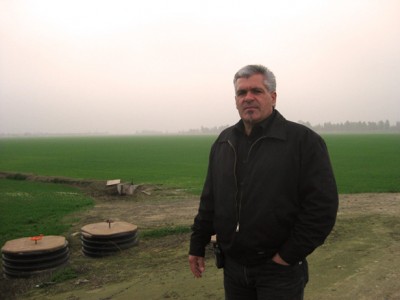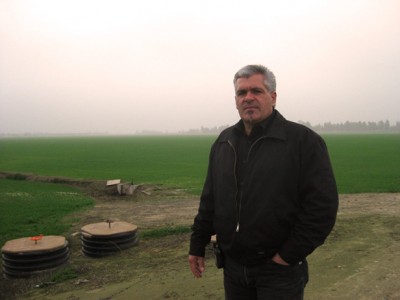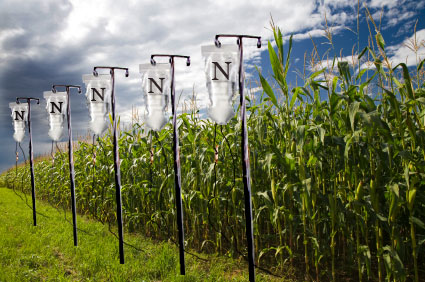 California dairy farmer Joey Rocha. Photo: Stephanie OgburnTurlock, Calif. — Joey Rocha tends 2,800 cows at his Central Valley dairy. That may sound like a large herd, but in California, Rocha is a mid-sized dairy producer.
California dairy farmer Joey Rocha. Photo: Stephanie OgburnTurlock, Calif. — Joey Rocha tends 2,800 cows at his Central Valley dairy. That may sound like a large herd, but in California, Rocha is a mid-sized dairy producer.
Taken together, California’s dairy cows produce more than 100,000 tons of manure every day. Rocha and his fellow dairy farmers put all those cow pies to good use — as fertilizer for the fields that grow the corn that feeds their herds. It’s a perfect closed-loop system, except for one big problem: nitrogen.
Manure is nitrogen rich, which makes it a great fertilizer. But by applying every last bit of manure to their fields, California dairy farmers — and non-dairy farmers as well — are dosing their crops with more nitrogen than the plants can absorb. The excess nitrogen is causing serious air and water pollution problems and may even be threatening the health of the soil.
There are ways around this problem: dairy producers and farmers could dial back on the manure and synthetic fertilizers they apply. But there’s not a lot of incentive to do this.
“[Fertilizers] are, in fact, relatively cheap and very good insurance,” says Allen Dusault, program director at Sustainable Conservation, a California group that works with farmers to develop economically-feasible approaches to environmental practices. “If you’re a farmer that is applying adequate amounts and then some, it’s good insurance to make sure you get your yields.”
Perverse incentives
Yields are the driving force of modern agriculture. Whether a farmer is growing corn to feed his dairy cows or someone else’s, he gets paid by the ton. If he can apply a little extra of something that is cheap or free (fertilizer or manure) in order to ensure a high yield, that’s a no-brainer.
Although most agronomists will tell you that farmers over apply nitrogen and can get the same yields without adding as much fertilizer and manure as they do, few farmers are willing to take that risk for an environmental benefit that doesn’t impact them.
Thus, nitrogen pollution from farms is really a kind of market failure: individual farmers have little or no incentive to act in a way that protects the groundwater beneath them. But the public does have an interest in clean water; and public action will likely be required to change the incentive structure.
Reducing risk
Allen Dusault, program director at Sustainable Conservation, a California group that works with farmers to develop economically-feasible approaches to improving environmental practices, has thought a lot about the N problem. What’s needed, he says, “is a way to insure the financial viability of crop production methods without creating such a surplus of nitrogen that you have runoff.”
That’s where risk-reduction programs such as the Best Management Practices (BMP) Challenge come in. The BMP Challenge, a unique program available in 18 major farming states, allows farmers to try environmentally-beneficial management techniques by offering to pay them for any costs they might incur in the process.
The program, originally started by American Farmland Trust and now run by a company called AgFlex, is focused mostly in areas where nitrogen runoff is causing big problems: the Chesapeake Bay, Mississippi River watershed, the Great Lakes Region, and now California dairies.
Farmers who enroll in California’s BMP Challenge agree to apply less manure to their corn, and to try and target that application at times when the corn will actually absorb most of the nitrogen in the manure. If farmers’ yields dip, the program compensates them for their loss. If their yields increase or hold steady, farmers pocket the savings from reduced fertilizer use and higher yields.
Rocha was one of the five dairy farmers that Dusault and Sustainable Conservation first approached in 2009 about taking the BMP Challenge. “We don’t look for these new programs,” says Rocha, whose environmental consultant turned him on to the program. “But when stuff comes our way, we do take a listen to it.”
Next year Sustainable Conservation hopes to enroll about 20 dairy producers in the San Joaquin Valley, according to senior project manager Ladi Asgill. The program is appealing, says Asgill, because it “offers an opportunity for dairies to experiment and work out the kinks in implementing a new practice, where we offer risk coverage, basically.”
Speaking of risk, Rocha did have slightly lower yields this year. But he also learned a lot about how to time his irrigations and apply manure more efficiently. With a few years practice, Rocha believes he could get to the point where he sees “the same [yields] with less [manure].”
Limiting risk is a key component in getting farmers to try new practices that have favorable environmental results, says Ferd Hoefner, policy director for the National Sustainable Agriculture Coalition[4], a D.C.-based policy group.
“There really is a barrier to adoption of practices, even practices that on average are great net-return kinds of practices for farmers,” Hoefner says. “They fear there will be some kind of cost of production.”
The BMP Challenge gets farmers over the financial hurdle. For Rocha, it was a “no-fear” option.
“There’s nothing unattractive about it,” he says.
Taking it national
Of course, paying farmers to try new practices can get expensive. Farm conditions vary and the program has to pony up to pay for yield reductions. Ideally, says policy analyst Hoefner, the program might work well as a kind of national insurance policy for farmers willing to try something new.
In Hoefner’s view, modest programs like the BMP Challenge could have a lot of short-term impact. But when it comes to creating truly sustainable agriculture systems, Hoefner says his organization would like to see more support for widespread systemic changes in how dairy farms, and other farming systems, operate. Such changes would include returning to traditional pasture-based grazing systems, and exchanging concentrated animal feeding operations such as Rocha’s for smaller livestock production approaches that integrate animals into farming systems with techniques such as rotational grazing.
The HDTV Challenge
Rocha didn’t get his usual yields last year, but he’s game to try the BMP Challenge or some other similar program again.
“If it’s out there next year, if there’s another program to be had, we’ll take a good hard look at it again,” he says. “If we wind up with … [a] little less nitrogen, that’s better for us, better for the ground.”
In the long run, what matters most is the effect that Rocha’s experiment has on his dairy farming neighbors. If they see him getting more yield with less manure, they may start doing what he’s doing — and if that happens, the practice of smart nitrogen use could snowball.
Sustainable Conservation’s Dusault calls programs like BMP Challenge “showcasing,” and likens Rocha to the early adopters who bought the first HDTVs. (25 percent of American households had high definition televisions in 2007; 50 percent had them in 2009.)
Manure management isn’t as much fun as watching Peyton Manning launch a Hail Mary in hi-def, though, and if California dairies follow the same trend as California farmers who failed to adopt conservation tillage, Dusault’s HDTV penetration model may not apply.
The truth is it’s too early to tell how effective the BMP Challenge for California’s dairies will be. What is clear is that unless government steps in to share some risk or change financial incentives, farmers across the country will likely continue overdosing their fields with nitrogen — to the detriment of our ecosystems and our health.



